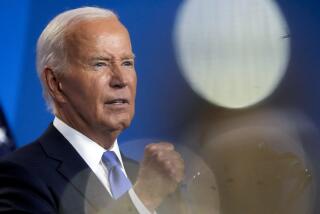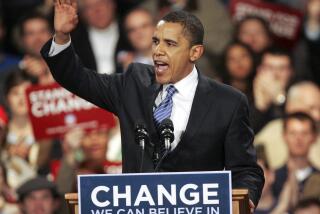Clear winner in ’08 nominating race: Iowa
- Share via
DES MOINES — For decades, there’s been one constant in national politics: Iowa has enjoyed an outsized say in picking America’s presidents.
But a backlash built over time, as outsiders questioned why a state so overwhelmingly white and rural should have so much clout. Last summer, Democrats moved to diminish the influence of Iowa and New Hampshire -- the traditional leadoff states -- by pushing Nevada and South Carolina to the front of the nominating calendar.
The move has worked, somewhat: White House hopefuls have started popping up in Las Vegas and Columbia, and there is talk of a spring debate in South Carolina.
But it’s clear that Iowa -- which will again cast the first votes of 2008 -- has lost none of its import. Indeed, it may be more important than ever.
John Edwards, the former North Carolina senator and Sen. John F. Kerry’s 2004 vice presidential running mate, has visited the state 15 times in the last two years. Sen. Evan Bayh of Indiana has been here 12 times. Barack Obama, the Illinois senator, visited three times this fall alone.
The courtship of key activists has been underway for months. Sarah Swisher, a nurse and labor leader in Iowa City, has spoken with more than half a dozen prospective Democratic candidates soliciting her views on healthcare and angling for support.
“It’s been intense,” Swisher said.
And the balloting is still more than a year away.
Wide-open race
There are two main reasons for the unprecedented flurry of activity. The 2008 contest is the most wide-open presidential race since at least 1952, with no president or vice president running. And once they finish tinkering, both parties will probably telescope a nominating process that was already front-loaded.
That makes it all the more critical to do well in Iowa, to build momentum heading into the rapid-fire series of contests that follow. Iowa’s caucuses are set for Jan. 14, 2008, followed five days later by caucuses in Nevada. The New Hampshire primary is tentatively set for three days later. South Carolina is scheduled to vote a week after New Hampshire.
“Iowa may not decide who the nominee is,” said Dan Pfeiffer, a spokesman for Bayh. “But it will decide who it isn’t.”
Even the presence of Iowa Gov. Tom Vilsack, who formally declared his presidential candidacy last month, has not kept Democratic rivals away. A day before Vilsack’s announcement in his rural hometown of Mount Pleasant, Edwards was halfway across the state in Des Moines, promoting his new book and drawing a crowd of several hundred despite temperatures that plunged into the 20s. Bayh showed up in Des Moines a few days later to address the city’s business leaders.
“Everybody’s determined not to get left behind,” said David Nagle, a former Democratic congressman who has been involved in Iowa politics for more than 30 years. “They know this is a state that requires a lot of care and attention.”
Iowa has been a crucial stop on the presidential campaign trail since 1972, when then-Sen. George S. McGovern of South Dakota used a strong showing to push past better-known rivals and capture the Democratic nomination. Four years later, another dark horse, former Georgia Gov. Jimmy Carter, won Iowa and, ultimately, the White House. Since then, presidential candidates have ignored the state at their peril.
“All sorts of contests are set up to establish a candidate’s viability: How much money has the candidate raised? Which organizers have they hired? What kind of website do they have?” said strategist David Axelrod, a veteran of several Iowa campaigns. “This is the first real contest.”
Republicans have their own reasons for showing up early and often. The party’s calendar may leave little time to recover from an Iowa stumble. Unlike 2000, when the gap was more than two weeks, the South Carolina primary will probably come just seven days after New Hampshire.
A straw poll set for next August may also be a significant, if unscientific, gauge of strength; in the 2000 campaign, the Iowa results effectively knocked several GOP candidates out of the race, months before any real ballots were cast.
By their nature, the Iowa caucuses require a substantial commitment of time and personal effort, on the part of candidates and the people who judge them. Voting for a presidential nominee here is not as simple as dropping by a polling place or mailing in a ballot.
The caucuses are small gatherings that can last for hours. They require participants to publicly state their candidate preference and, often, defend their choice to argumentative friends and neighbors.
“This is not an impulse buy,” said Doug Gross, a Des Moines attorney who leads Massachusetts Gov. Mitt Romney’s Iowa effort. “You want to get comfortable with a candidate, as a person as well as on key issues. That takes time. And the more time you spend in Iowa, usually the better the result.”
Early favorites
Romney, who has visited the state 11 times this year, has emerged as one of the early Republican favorites in Iowa, along with Sen. John McCain of Arizona. The first time McCain ran for president, as an insurgent in 2000, he skipped the caucuses to concentrate on New Hampshire. This time, McCain is focused on Iowa from the start; he has visited nine times this year.
“It’s a totally different campaign,” said Rick Davis, a McCain strategist. As a leader in national polls, McCain “has a responsibility to run in all 50 states, to show [he is] a national candidate,” Davis said.
On the Democratic side, the standings are more muddled.
Edwards and Bayh have established a strong presence alongside Vilsack, who will probably encounter much stiffer competition than Tom Harkin -- Iowa’s Democratic U.S. senator -- did when he ran for president in 1992.
Harkin, as a sitting senator, was considered unbeatable, so competitors avoided Iowa. Vilsack, by contrast, leaves office in January, losing the advantage of incumbency. He has also alienated key party constituencies, including organized labor and trial lawyers, and is more moderate than typical caucus-goers.
Many Democrats are waiting to see whether the candidates ahead in national polls -- Obama and Sen. Hillary Rodham Clinton of New York -- enter the race.
Obama recently began calling party leaders and activists to get “their sense of the lay of the land,” said Axelrod, one of his advisors.
Clinton, who stayed away from Iowa as she focused on her reelection, has also started reaching out. A group of Iowa Democrats was invited to Washington to dine with Clinton this week.
As the ardent courtship suggests, Iowa still has one thing going for it, even with Nevada and South Carolina crowding the calendar: First is still first.
*
(BEGIN TEXT OF INFOBOX)
Calendar change
Democrats have moved Nevada’s caucuses and South Carolina’s primary election toward the front end of their 2008 election calendar in an effort to reduce the effect of traditional calendar-openers Iowa and New Hampshire. Some think the latter two states’ atypical white, rural populations are not representative enough. How the four states compare:
*--* Pct. White Pct. Urban Iowa 92 61 Nevada 60 92 New Hampshire 94 59 South Carolina 66 61
*--*
Here’s the tentative Democratic calendar for the beginning of the ’08 season compared to the 2004 dates:
2008
(elapsed time: 23 days, nine
primaries, two caucuses)
Jan. 14: Iowa caucuses
Jan. 19: Nevada caucuses
Jan. 22: New Hampshire primary
Jan. 29: South Carolina primary
Feb. 5: Seven primaries (tentatively scheduled)
2004
(elapsed time: 16 days, six
primaries, three caucuses)
Jan. 19: Iowa caucuses
Jan. 27: New Hampshire primary
Feb. 3: Five primaries, including South Carolina, and two caucuses
Sources: Democratic National Committee, U.S. Census
More to Read
Get the L.A. Times Politics newsletter
Deeply reported insights into legislation, politics and policy from Sacramento, Washington and beyond. In your inbox twice per week.
You may occasionally receive promotional content from the Los Angeles Times.











